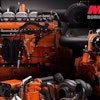
After winning a tender from RFI (Rete Ferroviaria Italiana; owner of the Italian railway network) to supply 88 self-propelled units, Tesmec assessed the options from several engine manufacturers and selected Volvo Penta as its supplier. The 16-L TAD1672VE was chosen due to a variety of reasons including its good power-to-weight ratio, excellent performance and fuel economy, and ease of installation.
“The choice of supplier came from a thorough comparison between the various solutions that are currently offered by the global marketplace, with a particular focus on the best compromise between the technological products, performance curves, power-to-weight ratio, fuel economy, and maintenance,” says Antonio Nitti, Rail Technical Director, at Tesmec. “Volvo Penta achieved an optimal result on all the parameters that were analyzed.”
On the right track
Tesmec Group, based in Grassobbio (Bergamo) in northern Italy, was founded in 1951, and now operates in more than 135 countries; it designs and sells products and integrated solutions for the construction maintenance and efficiency of infrastructure projects related to the transport and distribution of energy, data, oil and gas, water, electricity, and telecommunications – for both overhead and underground applications.
The contract to supply multipurpose railway vehicles to RFI consists of 26 units with two axles and 62 bogie vehicles; axle vehicles will be powered by one Volvo Penta engine, and bogie vehicles will have twin engine installation. The vehicles are designed to accommodate a basket and a loading crane (and a working platform on the bogie units); they carry out catenary work with the simultaneous removal and installation of overhead catenary lines, as well as any additional maintenance. Volvo Penta will deliver the engines by 2019; each vehicle is expected to operate for an average of 900 hours per year.  Volvo Penta TAD1672VE with SCR.
Volvo Penta TAD1672VE with SCR.
Powering a raft of benefits
The bogie vehicles can reach a max speed of 140 km/h, while the axle vehicle can reach a max speed of 120 km/h; in catenary work mode, both have a maximum speed of 9 km/hr.
Volvo Penta’s TAD1672VE is an off-road, in-line six-cylinder, 16.1-L diesel engine, that provides 515 kW at 1,800 rpm. It features electronic high-pressure fuel injection, overhead camshaft, and electronically controlled wastegate turbo. Optimized SCR technology and a light EGR contribute to efficient combustion. Tesmec has identified several benefits to using Volvo Penta’s engine:
- Compatibility with hydrostatic transmission.
- High performance of power transmission to hydraulic pumps.
- Wide torque curve range, giving maximum performance at low rpm.
- Great power-to-weight ratio.
- Excellent fuel consumption thanks to electronic injection control system.
- Reliable electrical management system.
- Low emissions with SCR catalyst.
- Low noise.
- Good aftersales support network.
In addition to the Italian railway deal, Tesmec foresees working with Volvo Penta on other projects. “Tesmec wants to strengthen its collaboration with Volvo Penta on an international level,” says Paolo Mosconi, General Manager of Tesmec. “We have recently won an important tender for a project in the U.S., where we will install the same TAD1672VE diesel engine.”
Volvo Penta has been working with Tesmec for several years in supplying engines for its stringing equipment, for the installation of power lines and fiber optic cables. The collaboration for the railway catenary vehicles is a welcome addition.
“For more than 60 years Tesmec has had a footprint in the infrastructure equipment market, and it is growing incrementally,” says Renato Deda, Volvo Penta’s Sales Manager, Italy and Spain. “They have seen that there is a great opportunity in producing equipment that expands and modernizes a country’s infrastructure, and we are happy to be part of this project for RFI in Italy.”



















